- Home
- Panfish
Bluegill vs Perch – What’s the Difference?
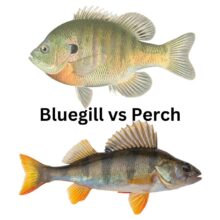
Bluegill and perch are two of the most popular freshwater fish species in North America and Europe. Both are members of the sunfish family, which also includes bream and bass.
Bluegill, also known as Lepomis macrochirus, is a type of sunfish that is found in ponds, streams, and lakes. They are typically yellow or green in color and have a distinctive black spot on their gill cover.
Perch, on the other hand, are members of the family Percidae and are found in freshwater habitats across North America and Europe. They are typically smaller than bluegill, with a more elongated shape and a darker coloration. Perch are carnivores and feed on a variety of small fish, crustaceans, and insects.
While both bluegill and perch are popular among anglers, they differ in several ways. Bluegill are known for their aggressive behavior and are often caught using a simple rod and reel setup. Perch, on the other hand, require a bit more finesse and are often caught using live bait or lures.
In terms of taste, both species are considered delicious when cooked properly, with bluegill being slightly sweeter and perch having a firmer texture.
Bluegill
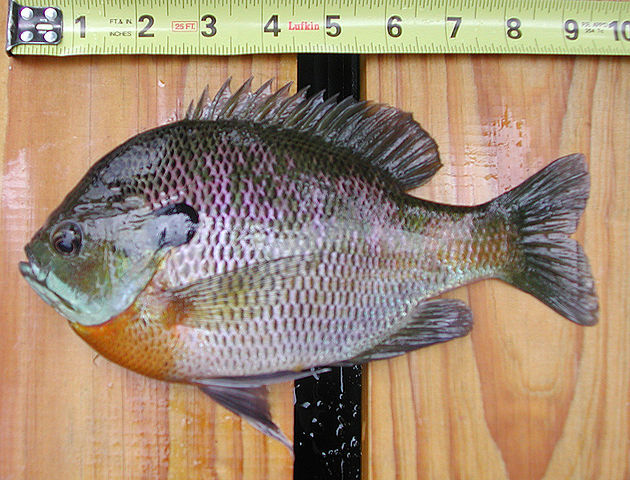
Appearance
Bluegills are a type of sunfish that are best known for their striking blue and green coloration. They have a compressed, oval-shaped body with a small mouth and a long dorsal fin that is spiny at the front.
Also Read: Shellcracker vs Bluegill
The bluegill’s scales are small and have a dark border, which gives the fish a mottled appearance. On average, they grow to be between 6 and 10 inches long and weigh around 1 pound.
Habitats
Bluegills are found in a variety of habitats, including lakes, ponds, rivers, and streams. They prefer warm, shallow waters with plenty of vegetation, as this provides them with cover and a source of food. They are also known to congregate around submerged logs and other underwater structures.
Eating
Bluegills are opportunistic feeders that will eat just about anything that fits in their mouth. Their diet consists mainly of insects, crustaceans, and small fish. They are also known to eat algae and other plant matter. When fishing for bluegills, small live baits such as worms, crickets, and grubs are often used.
Fishing
Bluegills are a popular game fish, especially among young anglers. They are relatively easy to catch and provide a good fight on light tackle. They can be caught using a variety of methods, including baitcasting, spinning, and fly fishing.
Also Read: What Time of Day to Catch Bluegill?
When fishing for bluegills, it is important to use light tackle and small baits to match their small mouths.
Overall, bluegills are a popular and abundant species of panfish that are enjoyed by anglers of all ages. They are known for their striking coloration, opportunistic feeding habits, and willingness to bite.
Perch
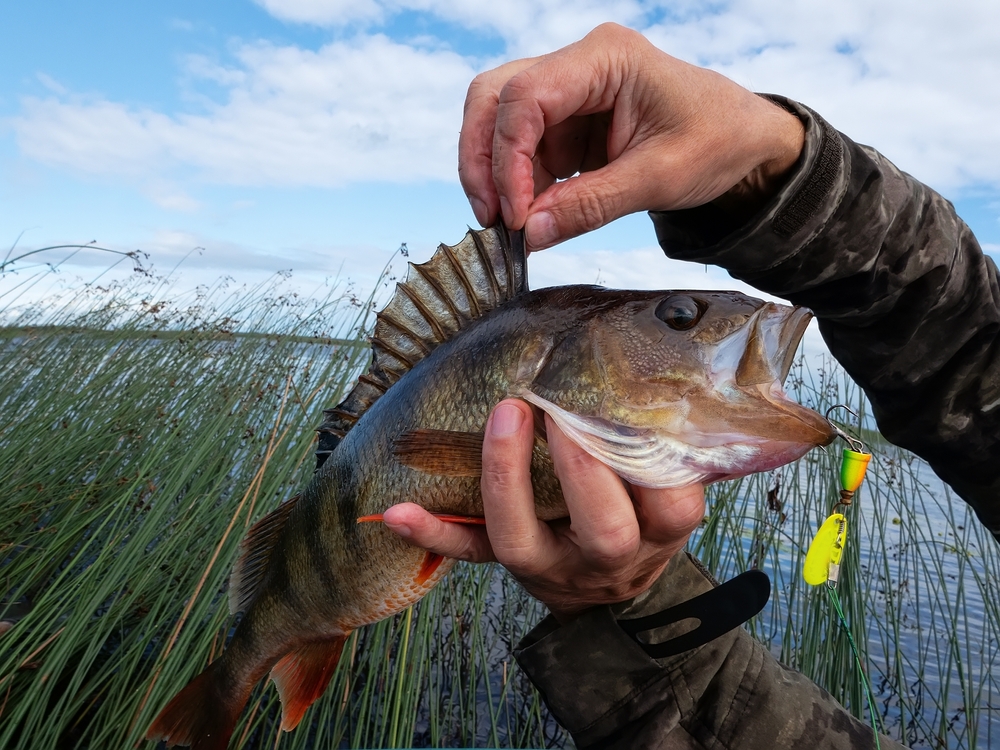
Perch is a freshwater fish that belongs to the family of Percidae. It is a popular game fish that is enjoyed by anglers in North America and Europe. There are several species of perch, including yellow perch and European perch. They are often confused with other freshwater fish, such as bass and bream, but can be distinguished by their shape and eating habits.
Appearance
Perch have a distinctive shape with a round body and a pointed snout. They are usually greenish-yellow in color with dark stripes on their sides. Yellow perch have a more yellowish color, while European perch are more greenish-brown. They can grow up to 15 inches in length and weigh up to 4 pounds.
Habitats
Perch can be found in ponds, lakes, streams, and rivers throughout North America and Europe. They prefer clear water with vegetation and rocky bottoms. They are often found near underwater structures, such as fallen trees and rocks. Perch also like to hide in weeds and other vegetation.
Eating
Perch are carnivores and feed on a variety of small fish, insects, and crustaceans. They are known to eat minnows, darters, and other panfish. They are also a favorite food of larger fish, such as largemouth bass and pike. Perch spawn in the spring and their nests can be found in shallow water.
Fishing
Perch are a popular game fish and are often caught using a rod and reel. They can be caught using a variety of baits, including worms, minnows, and other small fish. They are also known to bite on artificial lures, such as jigs and spinners. Perch have a firm texture and are often compared to cod in taste.
White Perch
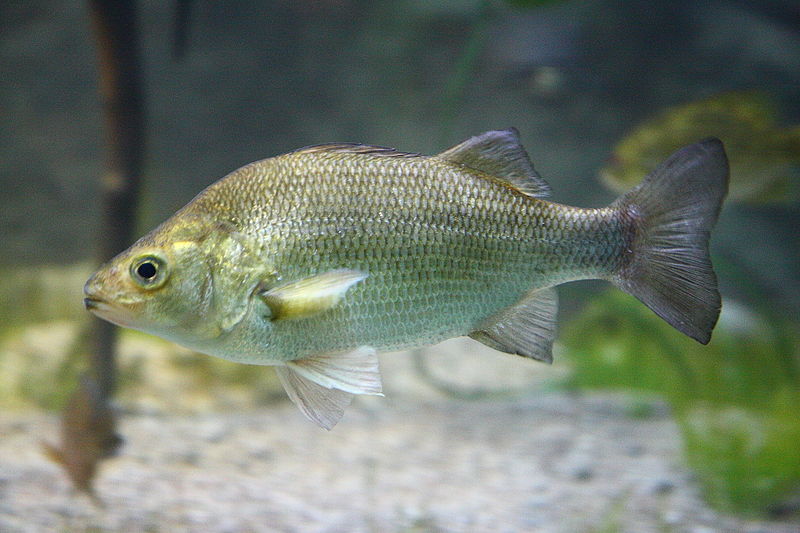
White perch, also known as silver perch, are often confused with yellow perch. They are a different species of fish, known as Abramis brama, and are native to Europe. They have a similar shape to yellow perch but are more silver in color. White perch are also a popular game fish, but are not as common as yellow perch in North America.
Other Species of Perch
There are several other species of perch, including rock bass, pumpkinseed, longear sunfish, and redbreast sunfish. They are all part of the genus Lepomis and are similar in appearance to yellow perch. They are also popular game fish and can be caught using similar methods as yellow perch.
In conclusion, perch are a popular game fish that can be found in freshwater habitats throughout North America and Europe. They have a distinctive shape and eating habits that distinguish them from other freshwater fish. They are a favorite food of larger fish, such as largemouth bass and pike, and are often caught using a rod and reel.
Bluegill vs Perch
Size
Bluegill and perch are both small fish, but bluegill tend to be slightly larger. Bluegill can grow up to 12 inches in length, while perch usually max out at around 10 inches.
Age
Bluegill and perch have similar lifespans, typically living for 4-6 years in the wild. However, bluegill tend to reach maturity faster than perch, with some individuals becoming sexually mature at just one year old.
Color
Bluegill and perch have distinct coloring that can help tell them apart. Bluegill have a blue-green back and yellow-orange belly, with dark vertical bars on their sides. Perch have a greenish-brown back and yellow-orange belly, with dark vertical stripes that run the length of their body.
Taste
Both bluegill and perch are popular game fish and are often eaten by humans. The taste of the two fish is often compared, with some people preferring the mild, sweet flavor of bluegill and others favoring the slightly stronger taste of perch.
In terms of nutrition, both fish are a good source of protein and omega-3 fatty acids. However, it is important to note that fish can accumulate environmental toxins, so it is recommended to limit consumption of fish caught in polluted waters.
Overall, while bluegill and perch have some differences in size, age, color, and taste, they are both popular game fish that provide a nutritious and tasty meal when caught and prepared properly.
Best Time of Day to Catch Bluegill
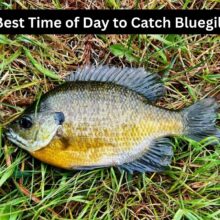
Bluegill is a popular freshwater game fish that can be found in many bodies of water across North America. Anglers enjoy fishing for bluegill due to their abundance, willingness to bite, and delicious taste.
However, catching bluegill can be a challenging endeavor, especially if you don’t know when the best time to fish for them is. In this article, we’ll discuss the best time of day to catch bluegill and offer tips and techniques to help you reel in a big one.
Bluegill Habits and Behaviors
Bluegill are opportunistic feeders that primarily eat small aquatic insects, crustaceans, and small fish. They tend to feed more actively during the warmer months of the year, especially when water temperatures are between 65 and 80 degrees Fahrenheit.
Bluegill activity levels are also affected by other factors such as weather conditions, water clarity, and moon phase.
Also Read: Perch vs Bluegill
Throughout the day, bluegill behavior patterns can vary significantly. In the morning, they are usually most active, as they have rested for the night and are hungry. In the afternoon, however, bluegill activity levels tend to decrease, as they seek shelter from the hot sun and become more sluggish.
In the evening, bluegill activity levels increase again, as they begin to feed in preparation for the night. Understanding these behavioral patterns is key to determining the best time to catch bluegill.
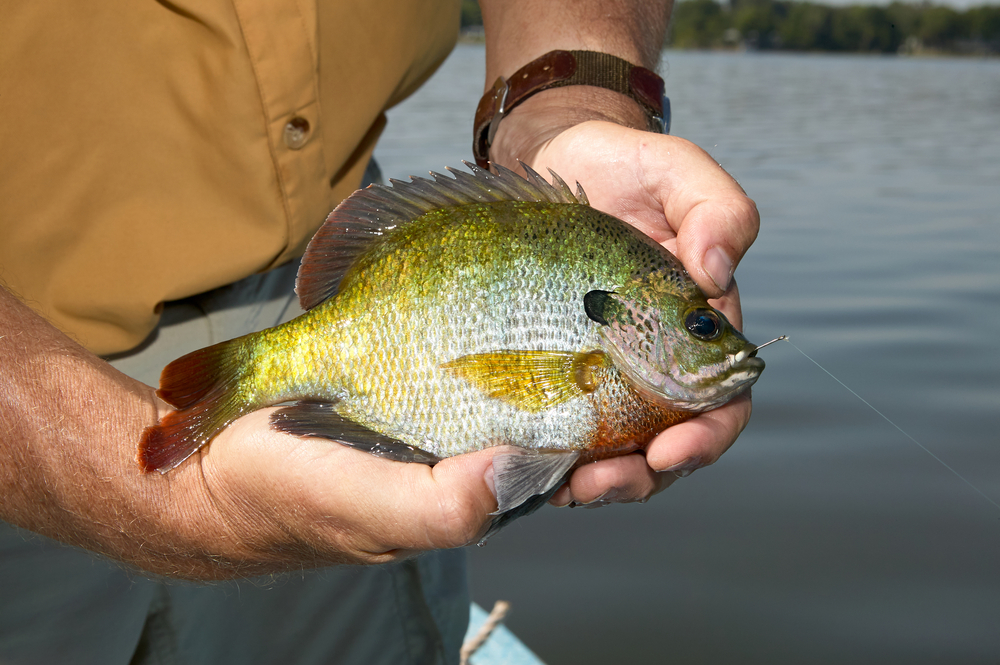
Best Times to Catch Bluegill
There are three main periods during the day when bluegill are most likely to be active and feeding: morning, afternoon, and evening.
- Morning: The morning is generally the best time of day to catch bluegill, as they are hungry and more active after a night of rest. During this time, bluegill can usually be found in shallower water, near the edges of the lake or pond.
- Afternoon: As the day heats up, bluegill activity levels tend to decrease. During this time, they may move to deeper water or seek shelter under overhanging trees or vegetation. Anglers may need to adjust their tactics, such as using smaller bait and presenting it in a more subtle manner, to entice bluegill to bite.
- Evening: In the evening, bluegill activity levels increase again as they prepare for the night. They can often be found in shallower water, near structure such as weed beds or submerged logs. This can be an excellent time to catch bluegill, especially during the summer months.
It’s worth noting that the best time to catch bluegill can vary depending on the location and time of year. Factors such as weather conditions, water temperature, and moon phase can all impact bluegill behavior, so it’s important to pay attention to these factors when planning your fishing trip.
Also Read: Can You Eat Bluegill?
Overall, the key to catching bluegill is to be patient and persistent. With the right timing and techniques, you can increase your chances of landing a big one.
Factors Affecting Bluegill Activity
To have the best chance of catching bluegill, it’s important to understand the factors that affect their activity levels. Here are some of the key factors to consider:
- Water temperature: Bluegill are most active when water temperatures are between 65 and 80 degrees Fahrenheit. As temperatures outside this range, their metabolism and feeding behavior are impacted, and they may become less active.
- Weather conditions: Bluegill can be affected by weather conditions such as cloud cover, wind, and precipitation. On cloudy days or when it’s raining, bluegill may be more active and feeding closer to the surface. On windy days, they may move to more sheltered areas.
- Water clarity: In clear water, bluegill can be more easily spooked and may be more cautious when approaching bait. In murky water, they may be less cautious, but it can also be more challenging to get their attention.
- Moon phase: Bluegill feeding behavior can be impacted by the moon phase. During a full or new moon, they may be more active at night and less active during the day. During a quarter moon, they may be more active during the day.
By understanding these factors and how they impact bluegill behavior, anglers can adjust their tactics and increase their chances of success on the water.

Tips for Catching Bluegill
Here are some tips and techniques for catching bluegill:
- Use the right equipment: When fishing for bluegill, use a lightweight rod and reel with a small hook and light line. This will allow you to feel bites more easily and present your bait or lure more naturally.
- Use the right bait or lure: Bluegill will bite on a variety of baits, including worms, crickets, and small jigs or spinners. Live bait tends to be the most effective, but artificial baits can also work well.
- Present your bait or lure correctly: When presenting your bait or lure, try to make it look as natural as possible. Use a bobber or float to keep your bait at the right depth and move it gently to simulate natural movement.
- Pay attention to your surroundings: Look for areas where bluegill are likely to be, such as around weed beds, submerged logs, or other structures. Pay attention to the water temperature, weather conditions, and moon phase, and adjust your tactics accordingly.
- Be patient and persistent: Bluegill can be finicky biters, so it’s important to be patient and keep trying even if you don’t get bites right away. Keep changing your bait or lure, adjusting your presentation, and moving to different areas until you find success.
- Practice catch and release: Bluegill populations can be sensitive, so it’s important to practice catch and release when possible. If you do keep fish for eating, make sure to follow local fishing regulations and only keep what you need.
By following these tips and techniques, you can increase your chances of catching bluegill and have a more enjoyable fishing experience.
Conclusion
In conclusion, bluegill can be a challenging but rewarding fish to catch. To increase your chances of success, it’s important to understand their behavior patterns and the factors that affect their activity levels, such as water temperature, weather conditions, and moon phase.
By targeting the best times of day to catch bluegill, using the right equipment and bait or lure, and paying attention to your surroundings, you can improve your chances of landing a big one.
Remember to practice catch and release when possible and follow local fishing regulations to ensure the sustainability of bluegill populations for future generations of anglers to enjoy.
Best Perch Bait
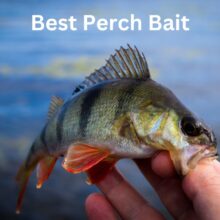
Perch fishing is a popular recreational activity enjoyed by many anglers around the world. Perch are a type of freshwater fish that are known for their aggressive nature and willingness to bite, making them a great target for anglers of all skill levels.
However, one of the most important factors that can determine the success of perch fishing is the type of bait used.
In this article, we will explore the different types of perch bait, their advantages and disadvantages, and provide tips on how to choose the best bait for successful perch fishing.
Natural Baits for Perch Fishing
Natural baits are a popular choice among many anglers when it comes to perch fishing.
Also Read: What Do Perch Eat?
These baits are usually readily available and can be found in or near the waters where perch are commonly found.
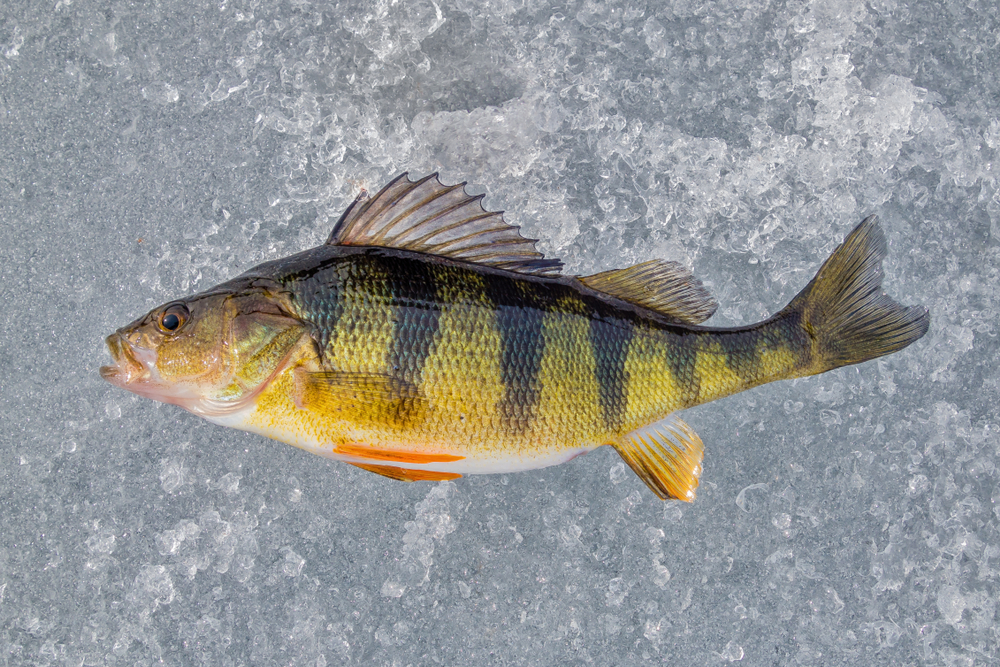
Some of the best natural baits for perch fishing include:
- Worms: Worms are a classic bait for many types of fish, including perch. They are readily available at most bait shops and can be dug up from the ground if you prefer to use fresh bait. Worms are particularly effective when fishing in shallow waters where perch tend to feed near the bottom.
- Minnows: Live minnows are another popular choice for perch fishing. They are particularly effective when fishing in deeper waters, as they can be rigged to swim at various depths. Small minnows are recommended for perch fishing, as larger minnows may attract larger predatory fish.
- Leeches: Leeches are a popular natural bait for perch fishing, particularly in areas with weedy or rocky bottoms. They are particularly effective when fishing in deeper waters, as they can be rigged to swim near the bottom where perch tend to feed.
Advantages of using natural baits for perch fishing include their availability and affordability. However, natural baits can be messy and may require more maintenance than artificial baits. Additionally, certain natural baits may not be as effective in certain fishing conditions or locations.
Artificial Baits for Perch Fishing
Artificial baits can be a great alternative to natural baits for perch fishing.

They are typically easier to use and require less maintenance than natural baits. Some of the best artificial baits for perch fishing include:
- Jigs: Jigs are a versatile artificial bait that can be used to mimic various types of prey, including worms and minnows. They can be rigged to swim at various depths and can be particularly effective when fishing in deeper waters.
- Spinners: Spinners are another popular artificial bait for perch fishing. They are typically designed to mimic small fish or insects and can be rigged to spin and flash in the water, which can attract the attention of hungry perch.
- Crankbaits: Crankbaits are a type of artificial bait that can be particularly effective when fishing in shallow waters. They are typically designed to mimic small fish and can be rigged to dive and swim at various depths.
Advantages of using artificial baits for perch fishing include their ease of use and durability. Additionally, they can be effective in a variety of fishing conditions and locations. However, artificial baits may not be as readily available as natural baits, and some anglers may prefer the feel and smell of natural baits.
Combination Baits for Perch Fishing
Combination baits can be a great option for anglers who want to combine the advantages of both natural and artificial baits.
These baits typically use a natural bait, such as a worm or minnow, as a base, and are then enhanced with artificial materials to make them more attractive to fish. Some of the best combination baits for perch fishing include:
- PowerBait: PowerBait is a popular combination bait that uses a blend of artificial scents and flavors to enhance the natural scent of the bait. It can be particularly effective when fishing in heavily fished waters or when perch are being finicky.
- Gulp! Alive: Gulp! Alive is another popular combination bait that uses a natural bait, such as a worm or minnow, as a base and is then enhanced with artificial scents and flavors. It can be particularly effective when fishing in murky or stained waters.
- Marabou Jigs: Marabou jigs are a type of combination bait that uses a natural feather, such as marabou, as a base, and is then enhanced with artificial materials, such as synthetic fibers or glitter. They can be particularly effective when fishing in shallow or weedy waters.
Advantages of using combination baits for perch fishing include their versatility and effectiveness in a variety of fishing conditions and locations. However, they may be more expensive than natural or artificial baits, and some anglers may prefer the simplicity of using a single type of bait.
Tips for Choosing the Best Perch Bait
When choosing the best perch bait, there are several factors to consider, including the fishing location, time of day, water temperature, and the type of perch you are targeting. Here are some tips to help you choose the best perch bait:
- Consider the Fishing Location: The type of bait you choose will depend on the type of water you are fishing in. For example, if you are fishing in shallow or weedy waters, jigs or marabou jigs may be more effective, while if you are fishing in deeper waters, live minnows or worms may work better.
- Time of Day: Perch tend to be more active during certain times of the day, such as early morning or late afternoon. Consider using baits that are more visible or have a more distinct scent during these times.
- Water Temperature: Water temperature can also play a role in the effectiveness of certain types of bait. In colder water, natural baits may be less effective, while artificial baits may work better.
- Target Perch Species: Different species of perch may have different feeding habits and preferences when it comes to bait. Research the specific type of perch you are targeting and choose a bait that is known to be effective for that species.
- Experiment: Finally, don’t be afraid to experiment with different types of bait to see what works best for you. Perch can be finicky at times, and what works on one day may not work on another.
Remember, the key to successful perch fishing is to choose the right bait for the conditions and to be patient and persistent.
Conclusion
Choosing the right perch bait is crucial to successful perch fishing. Natural baits, such as worms and minnows, can be effective and readily available, while artificial baits, such as jigs and spinners, can be easier to use and more durable.
Combination baits, such as PowerBait and Gulp! Alive, can offer the advantages of both natural and artificial baits.
When choosing the best perch bait, consider the fishing location, time of day, water temperature, and the type of perch species you are targeting. Remember to be patient and persistent, and don’t be afraid to experiment with different types of bait to find what works best for you. With the right bait and techniques, perch fishing can be a fun and rewarding experience for anglers of all skill levels.
What Do Perch Eat?
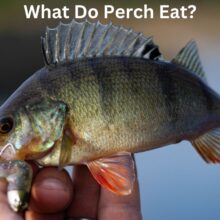
Perch are a popular freshwater fish found in many bodies of water around the world. They are known for their fighting spirit and tasty fillets, making them a popular target for anglers.
Knowing what perch eat is essential for successful fishing, as it helps to understand their behavior and feeding habits.
In this article, we will explore the natural diet of perch, as well as the best baits and lures to use when targeting these fish. Additionally, we will discuss different techniques for catching perch and provide tips for a successful fishing trip.
What Do Perch Eat?
- Small Fish
- Insects
- Crustaceans
- Worms
- Leeches
Natural Diet of Perch
Perch are opportunistic feeders that consume a wide variety of prey. They are known to feed both near the surface and on the bottom of the water column, depending on the availability of food.

The natural diet of perch varies depending on their size and location, but some common prey species include:
- Insects: Perch consume a variety of insects, including beetles, mayflies, and dragonflies. They often feed on the surface of the water where insects are more abundant.
- Small Fish: Young perch feed primarily on small fish, such as minnows and shad. As they grow larger, they may consume larger fish species.
- Crustaceans: Perch are known to feed on crayfish and other crustaceans found in the water.
- Worms and Other Aquatic Invertebrates: Perch are also known to feed on worms and other aquatic invertebrates, such as snails and clams.
When targeting perch, it is important to consider the natural diet of these fish and use bait or lures that mimic their prey. By doing so, you increase your chances of a successful fishing trip.
Artificial Baits and Lures for Perch
Artificial baits and lures are a popular choice for catching perch, and there are several options available that mimic the natural prey of these fish.
Here are some of the best types of artificial baits and lures for perch fishing:
- Jigs: Jigs are a versatile option that can be fished vertically or horizontally. They come in various sizes and colors, and can mimic both insects and small fish.
- Soft Plastic Baits: Soft plastic baits, such as worms and grubs, are effective for catching perch. They come in a variety of colors and sizes, and can be rigged in several ways.
- Spinners: Spinners are another popular choice for catching perch. They are available in different sizes and colors, and create a vibration and flash that can attract fish.
- Crankbaits: Crankbaits are effective for targeting larger perch, as they can mimic small fish and create a realistic swimming motion.

When using artificial baits and lures for perch fishing, it is important to consider the water conditions and adjust your approach accordingly.
Slow and steady retrieves are often effective, but it may be necessary to vary the speed or depth of your bait or lure to entice a strike.
Live Baits for Perch
Live bait is another effective option for targeting perch, and there are several types of live bait that are commonly used by anglers. Here are some of the best live baits for perch fishing:
- Minnows: Minnows are a popular live bait for catching perch. They can be fished on a hook or used with a small jig or spinner.
- Worms: Worms are another effective live bait for perch. They can be used on a hook or jig, and are available at most fishing supply stores.
- Crayfish: Crayfish are a natural prey of perch and can be used as live bait. They are typically fished on a hook or jig and are most effective in areas where crayfish are abundant.
When using live bait for perch fishing, it is important to use the right size and species of bait to match the natural prey of the fish. It is also important to keep the bait lively and active, as this can help attract fish.
Live bait can be fished on a variety of rigs, including Carolina rigs, slip bobber rigs, and bottom rigs. Experimenting with different rigs and techniques can help you find the most effective approach for your specific fishing location.
Techniques for Catching Perch
There are several techniques that can be used for catching perch, depending on the location and water conditions. Here are some of the most effective techniques for catching perch:
- Still Fishing: Still fishing involves using a stationary bait or lure and waiting for fish to bite. This technique is effective in areas with slow-moving water or where perch are concentrated in a particular spot.
- Drifting: Drifting involves allowing your bait or lure to drift with the current, typically using a float or bobber to keep it at a specific depth. This technique can be effective in areas with faster-moving water or when targeting fish that are scattered throughout the water column.
- Jigging: Jigging involves using a vertical jig or lure and moving it up and down to attract fish. This technique can be effective for catching fish that are suspended in the water column.
- Trolling: Trolling involves dragging a bait or lure behind a boat at a slow speed. This technique can be effective for covering a large area and finding actively feeding fish.
When using any of these techniques, it is important to pay attention to the behavior of the fish and adjust your approach accordingly. Perch may be more active during certain times of the day or in specific water conditions, so experimenting with different techniques and baits can help you find the most effective approach.
Conclusion
Knowing what perch eat is essential for successful fishing. Perch are opportunistic feeders that consume a variety of prey, including insects, small fish, crustaceans, and worms.
When targeting perch, anglers can use a variety of baits and lures, including jigs, soft plastic baits, spinners, crankbaits, minnows, worms, and crayfish. Different fishing techniques can also be employed, such as still fishing, drifting, jigging, and trolling.
By understanding the natural diet and behavior of perch, and experimenting with different baits and techniques, anglers can increase their chances of a successful fishing trip.
5 Types of Perch – What’s the Difference?
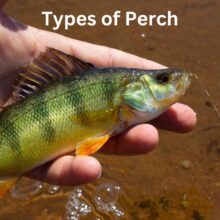
A perch is a type of freshwater fish that belongs to the family Percidae. They are found in many parts of the world, including North America, Europe, and Asia. Perch are known for their spiny dorsal fin and their two separate dorsal fins. They typically have a rounded body shape and can range in size from just a few inches to several feet in length.
Perch are carnivorous and feed on a variety of small aquatic animals, including insects, crayfish, and other fish. They are often found in shallow water near the shore, where they feed and spawn.
Perch are popular among anglers due to their abundance and delicious taste. They are often caught using small lures or baited hooks, and can be cooked in a variety of ways, including grilling, baking, or frying.
Different Types of Perch
1. Yellow Perch

Yellow perch (Perca flavescens) is a freshwater fish species native to North America, ranging from the Arctic Ocean to the Gulf of Mexico. Because of its exquisite taste and availability in many bodies of water, it is a popular game fish and is greatly sought after by anglers.
Yellow Perch have black vertical stripes on their sides and are often olive-green to golden-yellow in appearance. They are spherical and deep-bodied, with a spiny dorsal fin. They can grow to be up to 15 inches long, but are usually captured around 8-12 inches.
Also Read: Crappie vs Perch
Yellow Perch inhabit a wide range of freshwater settings, including lakes, ponds, and rivers. They are most commonly found in shallow waters, close to the beach, or in places with submerged vegetation. Perch eat aquatic creatures including as insects, crabs, and tiny fish.
Yellow perch are a valuable species in both leisure and commercial fisheries. Little jigs or live bait such as worms or minnows are usually used to catch them.
They are frequently filleted and prepared in a variety of ways, such as pan-frying, baking, or grilling.
2. European Perch
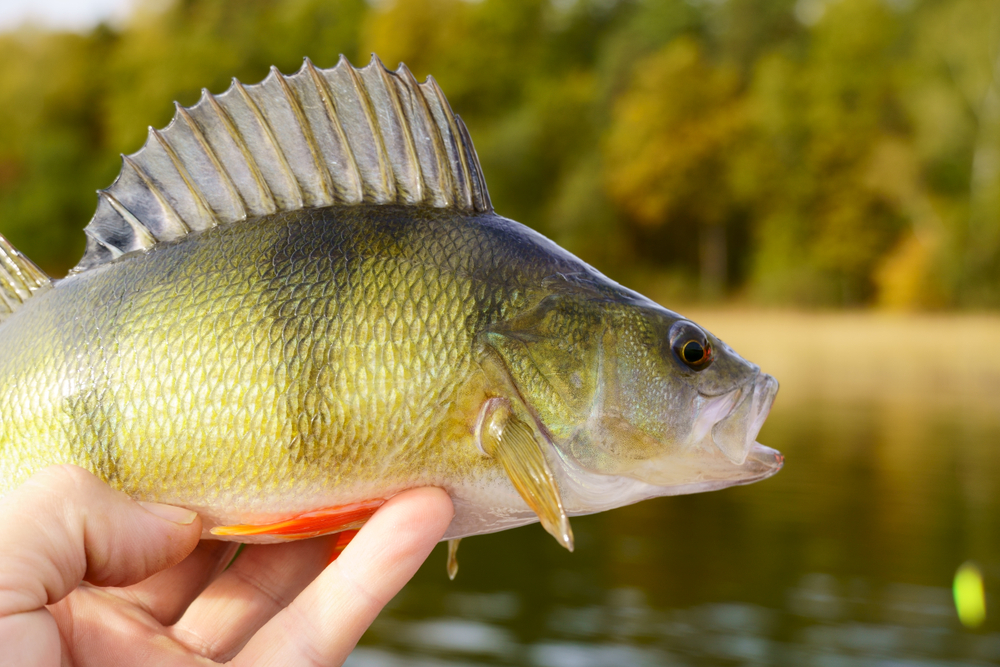
The European Perch (Perca fluviatilis) is a freshwater fish found in Europe and portions of Asia. Because of its size and sporting demeanor, it is a popular game fish and is much sought after by anglers.
The European Perch has an elongated, cylindrical body form with greenish-grey to brownish colouring and dark vertical stripes on its flanks. They have a spiny dorsal fin and can grow to be 60cm (24 inches) long, though they are commonly collected at sizes ranging from 20 to 30cm (8-12 inches).
European perch inhabit a wide range of freshwater habitats, including lakes, ponds, and rivers. They are most commonly seen in shallow waters near the beach or in regions where there is submerged vegetation. They eat aquatic creatures including as insects, crabs, and tiny fish.
Also Read: Best Perch Baits
European perch are a valuable species for both recreational and commercial fishing. Little jigs, spinners, or live bait like worms or minnows are usually used to catch them.
3. Balkhash Perch
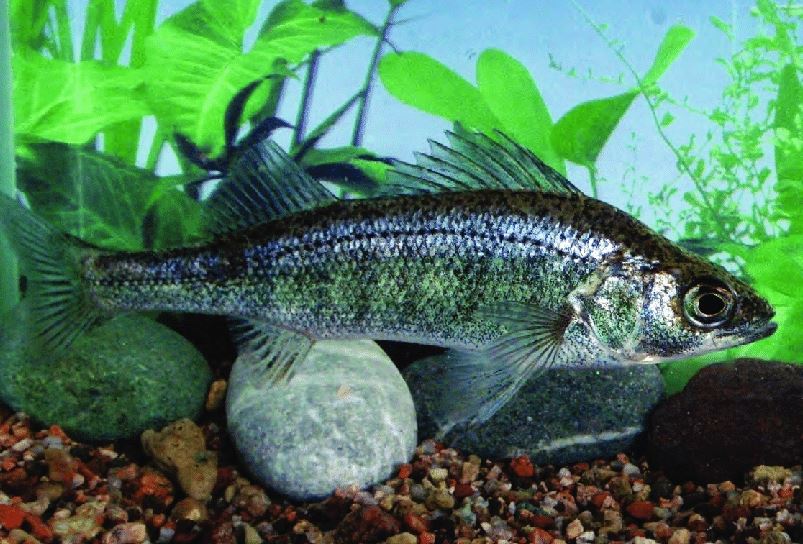
The Balkhash Perch (Perca schrenkii) is a freshwater fish species found in Kazakhstan and China’s Balkhash Lake. Schrenk’s Perch and Balkhash Marinka are other names for it.
The Balkhash Perch has a deep-bodied shape and a golden-brown tint with a white belly. They feature a spiny dorsal fin and dark vertical stripes on their sides. They can grow to be 50 cm (20 inches) long and 3 kg in weight (6.6 lbs).
Balkhash Perch can be found in Balkhash Lake’s huge, deep, and clean waters. They are usually found in open water or in rocky regions, where they graze on small fish and crustaceans.
In the Balkhash Lake region, the Balkhash Perch is an important commercial and recreational fisheries species. Little jigs or baited hooks are usually used to catch it, and it is frequently served by grilling or baking.
Unfortunately, due to over-fishing and habitat degradation, the number of Balkhash Perch has plummeted in recent years, prompting conservation efforts to conserve and restore their populations.
4. White Perch

White perch (Morone americana) is a freshwater and saltwater fish found throughout North America’s Atlantic coast, from the Gulf of St. Lawrence to South Carolina. The Silver Perch, White Nanny, and Gray Perch are other names for it.
White Perch have a deep body shape and are silver or white in color with dark vertical stripes on their flanks. They have two distinct dorsal fins with spiky and soft-rayed segments. They can reach 30 cm (12 in) in length and weigh up to 1 kilogram (2.2 lbs).
White perch inhabit a wide range of freshwater and estuarine habitats, including rivers, streams, lakes, and coastal bays. They often live in groups and feed on a range of small fish, crabs, and insects.
In the Atlantic coast, white perch is an important commercial and recreational fisheries species. It is typically caught with small jigs, spinners, or baited hooks and is frequently grilled or baked.
Yet, because of their aggressive eating behavior and competition with local fish species, the introduction of White Perch into non-native settings has produced ecological and economic difficulties.
5. Silver Perch
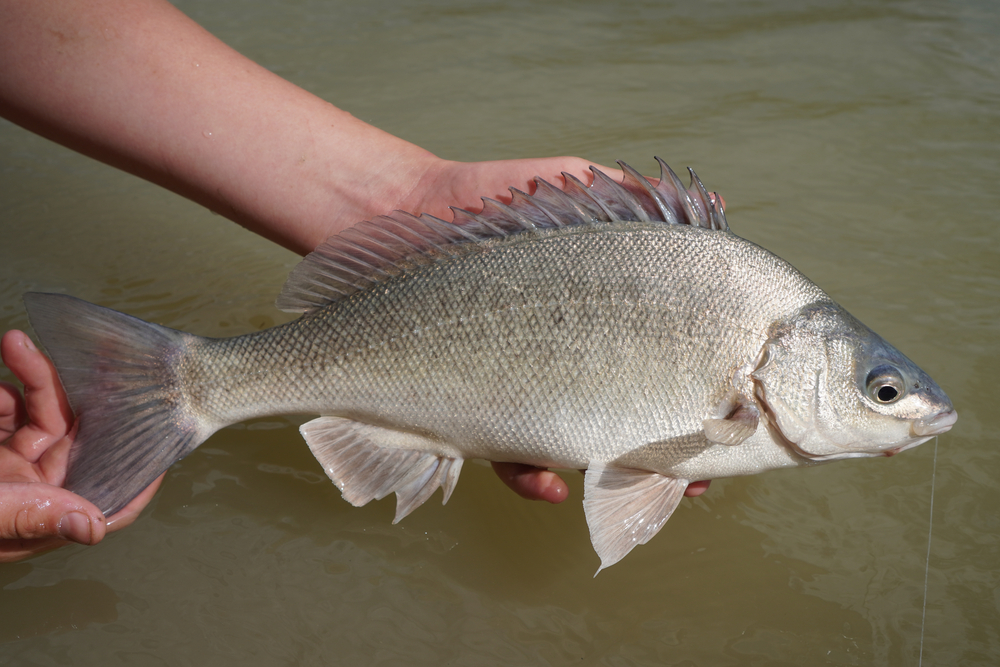
The silver perch (Bidyanus bidyanus) is an Australian freshwater fish. It is a common aquaculture species as well as a sport fisherman’s catch in many rivers and lakes.
Silver Perch have a deep-bodied shape and are silver or grey in color, with dark vertical stripes on their flanks. They have a big, spiny dorsal fin and can grow to be 45 cm (18 inches) long, though they are usually caught when they are 20-30 cm long (8-12 inches).
Silver perch inhabit a wide range of freshwater habitats, including rivers, lakes, and ponds. They like slow-moving or motionless water, near the bottom, or in places with submerged plants. They eat aquatic creatures including as insects, crabs, and tiny fish.
In Australia, silver perch is an important commercial and leisure fisheries species. They are commonly caught with baited hooks or small lures and are frequently grilled or fried.
They are primarily raised in ponds in aquaculture and are frequently given commercial fish feed. They are regarded as a prized species due to their rapid growth, resilience, and exquisite flavor.
Crappie vs Perch – What’s the Difference?
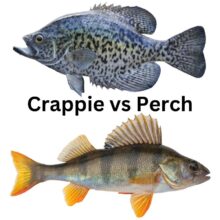
There is a long-standing debate between freshwater anglers as to which species makes better table fare—crappie or perch.
Both of these fish live in relatively the same types of environments and target the same kind of prey throughout most of the year. While their behavior and characteristics are very similar, their physical appearance is vastly different.
If you’re an angler that’s looking to learn the difference between crappie vs perch, we’ve compiled this article as a guide to help explain some of the major differences for both species.
Crappie vs Perch Overview
Based solely on the physical appearance, crappie and perch couldn’t be more different. Yet, these two species are some of the prime targets for freshwater anglers across much of North America.
The reason why so many anglers want to catch crappie or perch (or both) is mostly due to the fact that they are excellent table fare. The meat of crappie and perch offer a mild, sweet flavor that comes in a flaky texture, which is said to be the best of any freshwater fish species in the United States or Canada.

If you’re fishing for crappie or perch in an area where both species reside, odds are that you’re going to catch both as they are known to eat relatively the same kind of prey for much of the year. Crappie are known to live in deeper water for much of the year while perch tend to prefer more shallow regions of large lakes and reservoirs.
Both perch and crappie will spend much of their day in a school of their same species. Where you catch one crappie or perch, you’re very likely to find others nearby or in the same exact location. In the following sections, we’ll explain more about each species, as well as their behavior, habitat and when they spawn.
Crappie Overview
Crappie are said to be one of the most highly-prized fish found throughout the United States. They are part of the Sunfish family, but these great-tasting fish are known as ‘panfish’ due to the fact that they are outstanding table fare and their fillets and body profile is the perfect size to fit into most frying pans.
Anglers from the Deep South all the way up into the Great Lakes region and into Canada love to catch crappie for various reasons that include their filet quality.
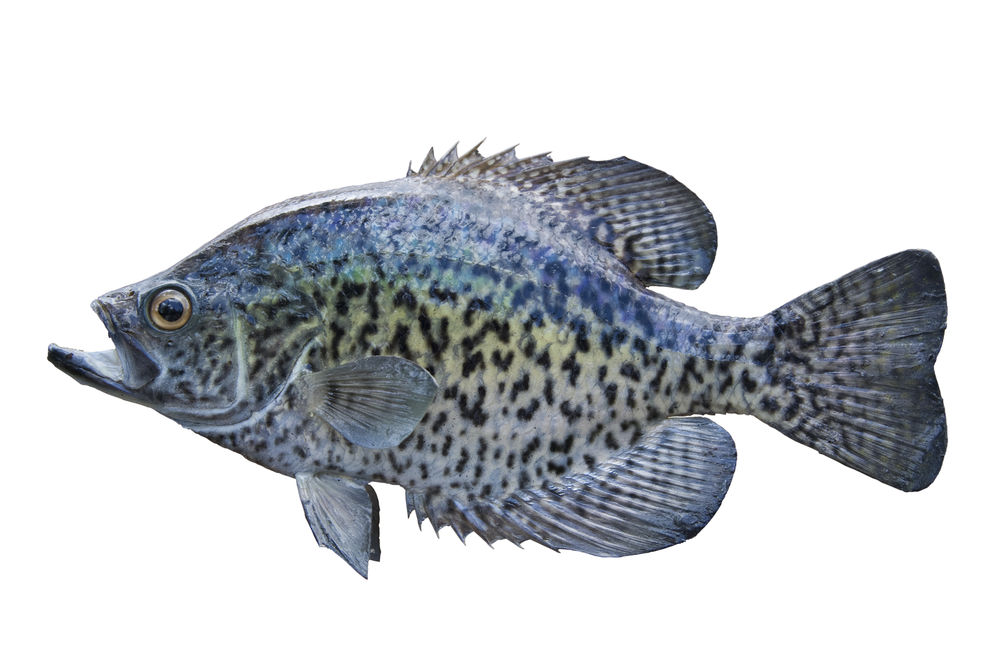
Found mostly in large lakes and reservoirs, crappie tend to live in sections of these waterways that offer some type of deep water cover such as brush piles, logs, standing timber, rocks and other structures. There are two types of crappie that include black and white crappie, both of which are virtually identical outside of their color pattern.
During times of extreme heat or cold, crappie will retreat down into the deep water sections of these bodies of water that offer cover in depths greater than 20 feet deep. When the outside temperature is less harsh during the fall, they are known to be in more shallow portions of these lakes.
Crappie spawn in the spring and this time of year is widely considered to be the best season for catching these types of panfish. They will migrate from their deep water abodes in early spring and will congregate in shallow cover that’s less than 10 feet in depth.
There is a saying throughout much of the United States that crappie spawn with the pink dogwood trees are in bloom and this rings true for sections of the country where these trees are located around large lakes and reservoirs.
Perch Overview
When most anglers throughout North America speak of perch, they are almost always talking about the yellow perch species, which is known scientifically as perca flavescens.
These fish are also known as panfish, yet they are part of the Perch family that includes vastly different fish species than that of the Sunfish family. The yellow perch is actually known as a semi-anadromous fish species, which means it is capable of living in both freshwater and brackish sections of rivers that join the ocean.

They are one of the smaller species of freshwater fish you’ll find throughout North America, but perch are known to put up quite a fight against a rod and reel. These fish will reach a size that’s comparable in weight to crappie, but is usually very different in terms of their body shape and profile.
Crappie prefer waterways that offer little to no current while perch usually like to spend their time in water that has a noticeable current.
Also Read: Bluegill vs Perch
During the cold weather months of the year, perch are known to venture down into the deeper parts of the lake or river water columns where they live. However, they will always begin their ascent back into shallow water when the outside temperature warms and the water heats up to at least 65 degrees.
Perch have spawning rituals that are different to that of the crappie and anglers often pinpoint this time of year to take place anytime from February or May.
Size Difference Between Crappie and Perch
As we’ve touched on earlier, crappie and perch do share a relatively similar body-weight when compared to one another, but their overall shape and profile is very different. Crappie have a more rounded shape while perch are known to be longer and have a head and tail that tapers down and narrows.
Crappie often measure about 4 to 10 inches in length and will reach 12 or 13 inches at full maturity. They will weigh in around 1 or 2 pounds in places where they are able to enjoy a long growing season, as well as an optimal diet. The world record crappie is a 5 pound, 7 ounce monster that was caught in Tennessee in 2018.
Perch usually grow to about 7 to 10 inches and their weight is often around 1.5 to 2 pounds in optimal conditions and with a well-rounded diet. Any perch that weighs more than 2 pound is considered to be a trophy-size fish and the world record is a 4 pound, 3 ounce giant that was caught in 1965.
Differences in Crappie and Perch
The major differences in crappie and perch might be obvious to experienced anglers, but it’s easy for beginners and novice anglers to confuse these two panfish species.
Here are some of the methods you can use to tell each species apart from one another.
Color
The most striking difference between crappie and perch, when compared side-by-side, is their color pattern. The crappie, whether it’s a white or black crappie, will have a white and black coloration that is often described as a ‘salt and pepper’ look.
The perch, on the other hand, has a vibrant range of colors that include deep green along their upper backs, a dark green vertical stripes along the sides and amber-yellow or yellowish-orange on their belly. The pectoral fins of the perch are usually brightly colored.
Body Shape and Profile
We’ve already noted the difference between crappie and perch as it relates to their body shape and profile, but it’s a point that bears mentioning again when referring to the major differences between these two types of fish.
Crappie will always have a body that’s more rounded in shape and their body will also be more flat, which means their filets are usually very thin.
Perch are known to have a body shape that’s built for speed and chasing down prey. Their bodies are more elongated and will usually appear to be a long, skinny fish during the juvenile stage while the mature yellow perch often have a noticeable bulging belly with a longer, tapering nose and tail.
Spawning Habits
One of the other major differences between crappie and perch that should be noted is the spawning rituals of both species.
Crappie are known to spawn earlier in the spring while perch usually wait until the water warms up to a more considerable degree in most lakes or rivers where they are found. Crappie like to spawn in water that’s roughly 4 to 8 feet of water in the backs of coves on large lakes and reservoirs.
The perch spawn often varies depending on where these fish are found throughout the United States. In the southern regions, they are able to enjoy warmer water temperatures earlier in the year and are known to spawn as early as February in some parts of the country.
In sections further north, the perch will have to wait until the cold air loosens its grip and the water temperature finally warms up to at least 45 degrees.
Conclusion
Anglers with more experience will often develop a better understanding of the differences between crappie and perch, but this article can serve as a handy guide to beginners looking to become better-acquainted with comparing the two. Using the tips we’ve provided here, you should have a greater understanding of how crappie and perch are different and you can use that knowledge on the water.
Can You Eat Bluegill?

It’s common for many anglers to wonder whether or not they can cook and eat bluegill. The short answer is, yes, but there are some specific things you should know before you attempt to clean and cook bluegill.
If you’re going to eat any type of fish, it’s important to understand the best way to cook that species for optimal results. In this article, we’ll discuss the different ways people often clean and cook bluegill.
What are Bluegill?
Many freshwater anglers throughout North America often catch and cook bluegill. They are found in abundance throughout much of the United States and Canada and they are very easy to catch, which makes them a good target fish for beginner anglers.
Bluegill are known under the scientific name Lepomis macrochirus. They are part of the Sunfish family, which includes more than 30 different species of panfish that are highly-prized by freshwater anglers for a number of reasons.
Bluegill are the most common species within the Sunfish family as they often thrive in almost any type of freshwater environment. They are native to the river systems throughout the southeastern United States, but bluegill have since been introduced to lakes, rivers and small ponds all across the North American continent.

They usually grow to be roughly 10 inches in length and the average bluegill often weighs around 1 or 2 pounds at full maturity. In the right conditions and with a good diet, bluegill are known to reach sizes of more than 12 inches in length. Any specimen that weighs in excess of 2.5 pounds is considered by serious anglers to be a trophy-sized bluegill.
Can You Eat Bluegill?
Yes, you can eat bluegill and they are actually considered by many anglers to be one of the finest freshwater delicacies you’ll find in North America’s lakes and rivers. There are a variety of different ways you can clean, prepare and cook bluegill that will bring out their flavor in the best ways.
There are no risks associated with consuming bluegill meat as you might expect with some species of fish. Bluegill are actually prized as one of the top panfish species to eat due to their clean diet and the fact that they prefer to live in clean, clear water.
Bluegill were a favorite target among pioneers and settlers in North America hundreds of years ago. They were highly sought-after and the fact that bluegill can be found in nearly any freshwater body of water.
Unlike other species such as bass, walleye and others, bluegill are relatively simple to catch and you can usually see them swimming around the edge of lakes and rivers where they are found.
What Does Bluegill Taste Like?
Many avid freshwater anglers consider bluegill to be one of the best-tasting fish you’ll find in North America’s waters. Compared to species like bass, walleye, muskie and others, bluegill offer a firm and flaky texture that is packed with flavor.
Their meat has a mild taste that is not strong or too fishy, which makes it one of the top species for introducing someone who’s never eaten freshwater fish before.
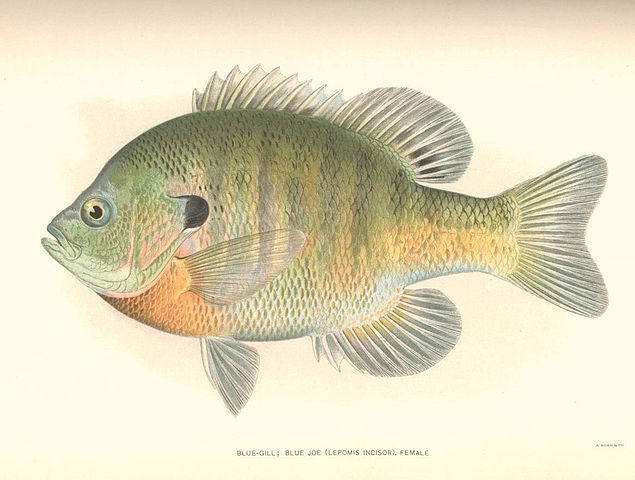
There is considerable debate among panfish anglers as to whether crappie or bluegill offer the best taste when it comes to freshwater fish.
Both species offer truly exceptional taste and meat quality, but bluegill typically have the best flavor regardless of how they are prepared and cooked. One of the main reasons why so many anglers overlook bluegill or don’t want to bother with cleaning and preparing a small filet.
How to Clean Bluegill
There are various schools of thought when it comes to the best way to clean bluegill. Since they are one of the smaller varieties of freshwater fish you’ll find in North America, most anglers don’t want to go through the trouble of cleaning and filleting such a small specimen.
However, those who do are often rewarded with an outstanding culinary delicacy that you can’t get anywhere else.
If you’re someone that prefers to filet their fish before cooking, you’ll need a sharp knife and a steady hand to filet bluegill. The most obvious difficulty in filleting bluegill is the small size of the fish, which leaves little room for error and makes it a true challenge to get a decent amount of meat off the fish’s bones without wasting any.
If you’re going to filet a bluegill, it’s usually best to have an electric filet knife as this will allow you to cut deeper into the fish without having to bear down as much as you would need to with a traditional filet knife. You should work to filet a bluegill just like you would any other fish by starting with your blade just behind the bluegill’s pectoral fin.
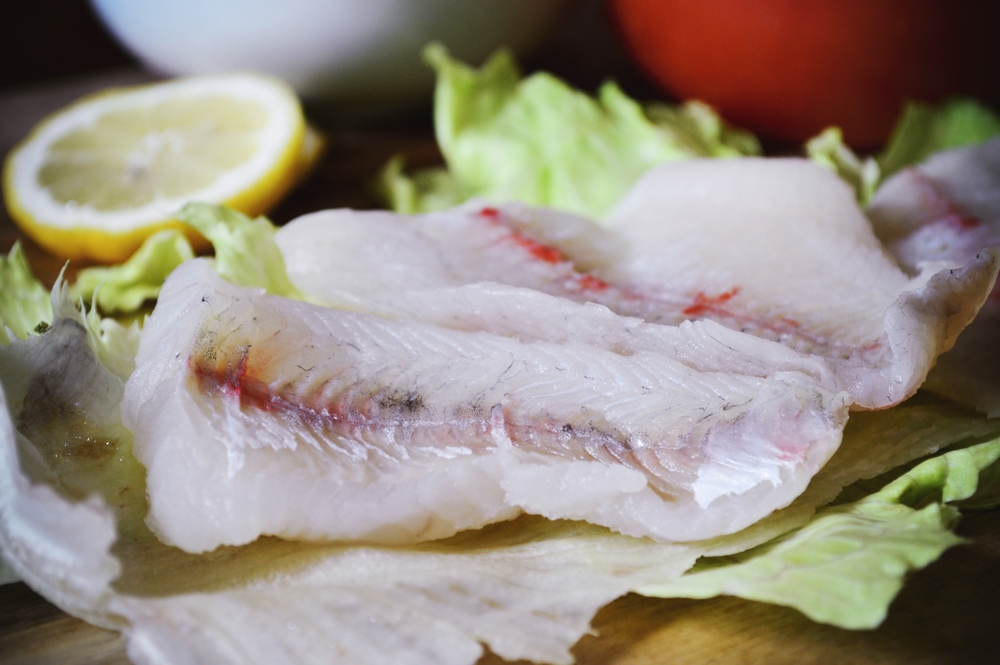
Cut down into the fish until you reach the spine and then angle your knife toward the tail while making sure to keep the blade as close as possible to the fish’s spine. Once you have fully flayed the fish open, you’ll want to cut into the base of the tail and continue working the blade back until you separate the skin from the meat.
Be careful to keep your knife blade between the skin and the filet in order to get as much meat as possible. Use the standard method of removing the small bones and flesh from along the bottom of the filet as you would for any other fish.
Can You Eat a Bluegill With the Skin On?
Yes! In fact, leaving the skin intact is one of the best ways to preserve as much of the bluegill’s outstanding flavor as possible. If you’re going to use this method, you’ll need to ‘scale’ the bluegill before cooking them. To do this, you can use a fish scaler tool, a spoon or a dull knife.
Scaling a bluegill is a more time-consuming process, but it offers a truly unique way of cooking these tasty fish that is considered to be a delicacy in the Deep South as many people will fry the bluegill with their skin, fins and tail still intact.
If you’re going to use this method, be sure to cut the bluegill’s head completely off by making an incision just behind the pectoral fin. Also, be sure to remove the fish’s guts and wash thoroughly before placing it in the batter or into the frying pan.
Best Bluegill Recipes
As we’ve already mentioned, there truly isn’t a wrong way to cook a bluegill. These small, but tasty fish offer a flavorful meal in just about any way you want to cook them. If you’re looking for some of the best bluegill recipes, there are plenty of online sources that offer great recipes for beginners, as well as seasoned experts.
You can find a great recipe for scaled bluegill here that’s relatively easy to prepare and cook. If you’re going to use this recipe, be sure to carefully remove all of the scales from each side of the bluegill, as well as the guts and innards before cooking.
For those who have an affinity for fried bluegill, there are plenty of recipes and cooking methods you can use. In fact, most standard fried panfish recipes will work exceptionally well with bluegill filets, but this Pan-Fried Bluegill Recipe is one that is well-worth a try.
If you’re looking for a recipe that’s more healthy than the typical fried fish cuisine, here’s a link to 3 Simple and Easy Panfish recipes that do not involve frying your catch. Even when the filets are grilled, baked or even air-fried, it’s hard to find a better-tasting fish than bluegill.
Can You Eat Bluegill Raw?
One of the most common questions asked by beginners and those who are largely unfamiliar with panfish and bluegill is whether or not these fish can be eaten raw.
There are many fish that can be safely consumed raw as long as you are very careful to clean your meat and check to make sure there isn’t a great risk of encountering dangerous parasites.
It’s generally not recommended that you eat raw bluegill as there are many unanswered questions regarding the body of water where the fish was caught, as well as the presence of any sort of infection that would contaminate the meat.
Bluegills typically do not succumb to the types of parasites that other fish encounter because their diet consists of a wide variety of different creatures instead of mostly other small fish.
The short answer to this question is yes, you can eat raw bluegill, but do so with extreme caution.
Conclusion
If you’ve never eaten bluegill before, you should certainly place this species next on your list of freshwater fish to try cooking and eating.
This article should serve as a guide for cleaning, preparing and cooking bluegill in a way that will be favorable to anyone’s tastes. Like most anglers, once you get a taste for bluegill, you’ll understand why they are America’s favorite panfish.
Shellcracker vs Bluegill – What’s the Difference?
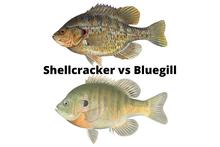
Sunfish are one of the more prevalent species of fish found throughout North America. With more than 30 different species in the sunfish family, it’s sometimes tough for even experienced anglers to know the difference between certain species, especially when it come to shellcracker vs bluegill.
In this article, we’ll cover some of the major differences between shellcracker vs bluegill and discuss various ways you can identify both species.
Shellcracker vs Bluegill
The shellcracker is a common nickname for a popular sunfish species called a redear sunfish. The nickname is mostly derived from the fact that the redear sunfish often eats small snails, mussels and other creatures that have shells. The shellcracker has deep-set teeth which they use to crush and break shells in order to devour the organism living inside.
Bluegill are also very popular throughout many of the freshwater lakes and rivers throughout North America. They are often found alongside shellcrackers and many other species of panfish and sunfish, which usually makes it difficult to tell them apart.
Also Read: Bluegill vs Sunfish
Their behavior and habitat are very similar, but there are some distinct differences between shellcracker and sunfish that you can use to distinguish these types of fish from one another.
In the following sections, we’ll discuss shellcracker and bluegill in more detail and cover some of the ways anglers use physical features, characteristics and other traits to tell shellcracker and bluegill apart from one another.
What is a Shellcracker Fish?
The common redear sunfish, or shellcracker, is very similar to bluegill in many ways. There are many similarities between these two fish species that make it difficult for even experienced anglers to tell them apart. The shellcracker’s scientific name is Lepomis microlophus, but the fish is known by various nicknames that include Georgia bream, red gills, chinquapin and others.
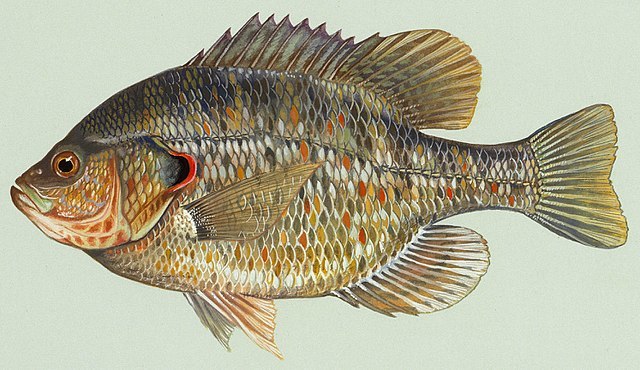
Many novice and beginner anglers commonly mistake these fish for bluegill or refer to them as ‘bream.’ It’s similar in shape to many other sunfish species, but shellcrackers typically have a deep body profile and a very small mouth. When compared to other sunfish, the shellcracker’s mouth is usually much smaller than most other variations.
Their diet consists mostly of snails and mussels, but shellcrackers will also eat almost any kind of insect, small grubs or other creatures they find in their natural habitat. Their fins are oriented in such a way as is common to most other sunfish species and they are virtually indistinguishable from bluegill to the casual observer. Shellcracker also have the distinct black spot in their ‘ear’ position that many other sunfish species also possess.
When it comes to the specific habitat or location where you might find shellcrackers, they live mostly in the southeastern United States and are not known to live in any freshwater bodies of water in the northern reaches of America. They have been introduced to places like California, Michigan and Kansas, but their natural boundaries are around the southernmost states in an area commonly referred to as the Deep South.
What is a Bluegill?
Bluegill are probably the most common freshwater fish found throughout North America, especially in the southeastern portion of the continent. They are not necessarily a large species of fish, but they typically school together in groups in order to ward off any predators or other threats.
Many freshwater game fish species such as bass, walleye, muskies and others often seek out bluegill as a staple part of their diet, making bluegill an integral part of any freshwater ecosystem.

These fish are scientifically known as Lepomis macrochirus, but are given a slew of nicknames by anglers that include coppernose, bream, brim, blues, sunny and others. While it is true that bluegill are often the prey when it comes to their relationship with other larger freshwater fish species, they are known to be opportunistic predators in their own right. Bluegill commonly feed on a wide variety of insects, frogs, smaller fish, and other creatures found in their habitat.
The native habitat of bluegill is much of the freshwater lakes and rivers throughout the southern half of the North American continent, but in the last century they have been introduced to western states like California and are known to thrive in parts of southern Canada as well.
Shellcracker vs Bluegill Size
It’s well-known that both shellcracker and bluegill are considerably smaller than many other freshwater species that live within the same bodies of water where these fish are found. However, they can grow to immense sizes in the right conditions and with an optimal diet. A mature, hefty bluegill or shellcracker will put up a ferocious fight against any angler’s rod and reel as they use their wide and powerful frame to dive and pull towards the bottom.
Shellcracker are actually the largest fish in the sunfish family. They are capable of growing at a much faster rate than their relatives and a full-grown shellcracker often reaches a length of 7 to 12 inches and a weight of roughly 1 pound. However, it’s not uncommon for shellcracker to grow to more than 2 or 3 pounds in the right conditions.
Areas that have warm climate and plentiful food often produce giant shellcrackers. The current IGFA world record for shellcracker (redear sunfish) is a 6-pound, 4-ounce monster that was caught in Lake Havasu, Arizona in 2021.
Bluegill are capable of growing to roughly the same size as shellcracker if they have ample food and live in a warm climate that offers a long growing season. These fish typically grow to about 8 to 12 inches in length and might weigh-in anywhere from 1 to 2 pounds in most areas. Like shellcracker, bluegill are capable of reaching extreme sizes compared to other sunfish varieties.
The IGFA world record bluegill was caught decades ago in 1950. The fish came out of Alabama’s Ketona Lake and tipped the scales at a whopping 4-pounds, 12-ounces. There have been many cases in which anglers claimed to have caught bluegill that weighed more than 5 pounds, but none of these fish were weighed on certified scales.
Differences Between Shellcracker and Bluegill
There are some obvious differences between bluegill and shellcracker, as well as other things about each species that are only evident to experienced anglers who know what to look for. If you’re hoping to be able to quickly and confidently identify the differences between shellcracker and bluegill, the following items should be taken into consideration.
Ears
The most common way anglers usually distinguish shellcrackers from bluegill is to look at the fish’s operculum, which is often referred to as the fish’s ‘ear.’ When it comes to bluegill, this ear will be completely black and will be very easy to identify as it clearly stands out against the green, blue and orange colors around the fish’s gills.
The shellcracker is known as a redear sunfish because of the appearance of this species’ operculum. Shellcrackers have a black ear that features a very bright red-colored outline. This red color will stand out against the fish’s light gray, green or even copper-toned scales along the side of its body.
Fins and Tail Color
The shellcracker’s fins and tail often have a shape and orientation that’s virtually identical to that of a bluegill. However, a shellcracker’s fins are always going to be lighter in color and will usually have a yellow or olive tint. The bluegill’s fins and tail will always be much darker and will appear to be dark green in color.
Eye Color
Another way you can tell the difference between a shellcracker and bluegill is to look closely at the color of the fish’s eye. Bluegill will usually have a very dark green complexion when it comes to their scales, fins and even their eye-color. The bluegill’s iris will have a dark green color while the pupil will always be jet black.
A shellcracker’s eye is distinctly different when compared to a bluegill as the color is obviously brighter. Shellcrackers have an iris that’s bright red or orange in color and might even appear to be yellow in some cases. The shellcracker’s pupil will be black, but the fish’s eye color is a marked difference from the bluegill’s dark green iris.
Body Shape
The shellcracker’s body profile or shape is always going to appear more elongated than a bluegill. Many anglers describe the shellcracker as having a ‘pointed nose’ compared to the bluegill’s more bulky appearance that makes the fish look more round and stout instead of longer in shape. In most cases, a bluegill’s body will have more girth or thickness compared to a shellcracker.
Conclusion
If you’re planning to go fishing for sunfish, you might encounter both bluegill and shellcracker in the same parts of any body of water. Using the information we’ve laid out in this article, as well as the four ways you can tell the difference between each species, you can easily identify whether your fish is a shellcracker or bluegill.
Perch vs Walleye – What’s the Difference?
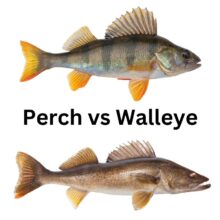
When perch and walleye are very small, they often share many similarities that might cause some anglers to mistake one species for the other.
Walleye do belong to the same scientific family category as perch, but these two fish have lots of differences that you’ll need to know if you want to be able to tell the difference between perch and walleye.
In this article, we’ll discuss these two fish species in greater detail and cover some of the main differences when it comes to perch vs walleye.
Perch vs Walleye Overview
Walleye and perch are actually part of the Perch family, which is scientifically titled the Percidae family. Some of the other fish species that belong to this family include sauger, perch, walleye and many other distinct species like darter fish and others. Many of these fish have the same basic body shape with similar large dorsal fins, as well as tail fins.
When comparing perch and walleye, you will notice that the two types of fish have quite a few features in common. They both have a very similar elongated body shape, large spiked dorsal fins, as well as other features like their color pattern.
However, these two fish will start to become more and more different from one another once they grow to maturity.
It’s well-known among anglers that walleye can grow quite large and are often some of the bigger species of game fish that fishermen like to target—mostly for their sheer size. Perch, on the other hand, are much smaller than walleye when they reach their full size potential.
Aside from this difference, it’s understandable why so many people confuse perch for walleye when these fish are in the juvenile stage because they look incredibly similar.
Both perch and walleye live in freshwater lakes and rivers throughout North America. Perch are known to be one of the most highly-adaptive species of fish that are known to live in the continent, but different variations of perch are found all over the world.
The perch is a unique type of fish that is semi-anadromous, which means it’s capable of living in both freshwater and saltwater.
In the following sections, we’ll discuss each type of fish in more detail.
Perch Overview
The type of perch that looks most similar and is most likely to be confused with walleye is the yellow perch. This fish is said to be semi-anadromous because it’s capable of living in virtually any type of freshwater lake or river system, as well as brackish, saltwater areas of rivers that join the ocean.
When an angler mentions perch, specifically in the United States or Canada, they are almost always referring to the yellow perch species.

Perch are typically a smaller fish that many anglers target for their meat as they are considered to be good table fare. These fish typically don’t grow to the large sizes that walleye are capable of reaching, but perch are usually comparable to some of the other freshwater species like bluegill or crappie as far as their size.
You can find perch in the shallow sections of most river systems, ponds or large lakes and reservoirs. In most cases, they prefer to live in water that doesn’t have a strong current, which makes larger lakes and reservoirs a better environment.
Perch are more suited to living in clear freshwater areas where they feed on a number of different types of prey, including insects and other small fish.
Walleye Overview
Walleye are also found in most of the freshwater lakes and rivers across the upper half of America, as well as Canada. They are especially prevalent in the eastern half of both countries and many anglers consider them to be one of the most enjoyable freshwater fish species to target for a number of reasons.
Walleye are considered one of the better-tasting freshwater fish species in North America, but they are lots of fun to catch as well.
Much like perch, walleye don’t typically prefer to live in freshwater habitats that have a strong current. Large reservoirs or lakes are much more suitable and, since they grow to a larger size than perch, walleye will generally be found in the deeper sections of lakes.
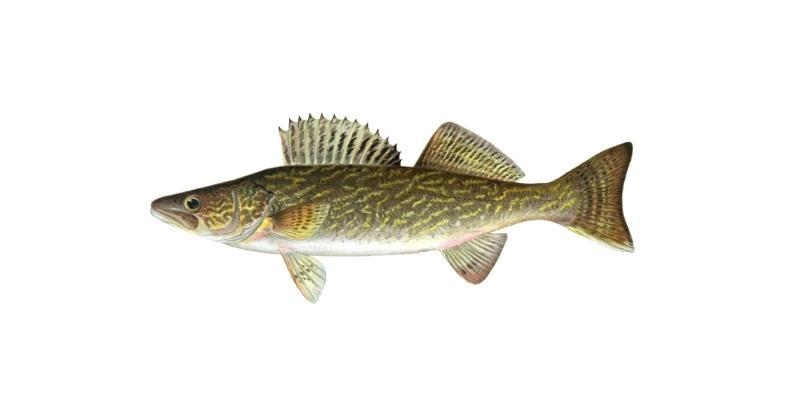
It’s common to find walleye across parts of Europe and Asia, but there are some differences between North American walleye and their European counterparts.
Walleye derive their name due to the strange pearlescent appearance of their eye, which is a result of a special reflective layer of pigment called the tapetum lucidum. This highly-unique pigment helps walleye see in the dark and makes it much easier for them to detect prey in the deep, dark waters of most lakes and reservoirs.
They are considered to be one of the more popular freshwater fish across the northern United States and eastern Canada. Walleye are a very popular species for ice anglers, but are also incredibly fun to catch during the spring when they are engaged in their annual spawning preparation and shortly afterwards.
Perch and Walleye Size Differences
As we noted already, perch are quite a bit smaller than walleye and the main confusion between the two species comes from specimens that are in the juvenile stage of life. Perch are considered to be a smaller species of freshwater fish throughout North America.
The average size of a yellow perch is usually about 7 to 10 inches and most perch will weigh anywhere from 1.5 to 2 pounds in optimal conditions and with a solid diet. The world record yellow perch is a 4 pound, 3 ounce fish that was caught in New Jersey in 1865.
Walleye typically grow to be roughly 25 to 30 inches when they reach full maturity and often weigh about 10 to 15 pounds in the best of conditions. The world record walleye is listed as a 25 pound specimen that was caught in a Tennessee lake in 1960, yet there is much controversy surrounding this catch and its actual weight.
Perch and Walleye Differences
The major differences between perch and walleye are evident to most experienced anglers, but newcomers to the sport of fishing might not be able to tell these two apart so easily. The following identification points are things you can use to confidently tell the difference between perch and walleye.
Eyes
The most obvious and reliable method of telling the difference between perch or walleye is to examine the fish’s eyes. As we’ve already stated, a walleye’s eyes have a distinct appearance that makes the fish look like it’s staring blankly at no certain point.
Many years ago, a person who stared indistinctly was said to have been ‘walleyed’ and the fish was given the name ‘walleye’ due to this cloudy, opaque eye color and appearance.
A perch’s eye is very different and appears much like you would expect the eye of any other type of freshwater fish in North America to look like. The eye of the perch has a green or amber-colored iris and a solid-black pupil.
Stripes
The coloration and color pattern of perch and walleye appear very similar at first glance, but each type of fish has slight differences you’ll notice upon further inspection.
Perch are well-known for having very distinct stripes on the sides of their bodies. These stripes are vertically-aligned and are typically very distinct and defined compared to the yellowish-green color of the fish’s sides.
The stripes on a walleye are much less defined and these markings will fade with time as the fish becomes more green in color across its back and sides. However, when a walleye is still in the juvenile stage, it typically has vertically-aligned stripes that appear to be similar to the ones that are present on a perch.
You can tell these two types of fish apart by examining the darkness of the stripes compared to the fish’s overall coloration. A perch’s stripes will be very defined while a walleye’s stripes will be faint.
Belly Color
The third main way you can tell the difference between a perch and a walleye is to examine the color of the fish’s belly and pelvic fins. Perch, in most cases, will have an amber-colored belly and pelvic fins. This color might even appear to be bright orange, which is similar to the belly of a bluegill in many ways.
This yellow or orange coloration to the perch’s belly will usually become brighter and more vivid as the fish ages and matures, making fully-grown perch one of the more colorful specimens in North American freshwater lakes and rivers. A walleye’s belly will be white in contrast.
Conclusion
When viewing perch vs walleye side-by-side, it’s easy to see why so many anglers can become confused. However, with ample time on the water and enough fishing experience catching both species, you can use these different identification points and confidently be able to tell these two fish apart with relative ease.
White Crappie vs Black Crappie – What’s the Difference?
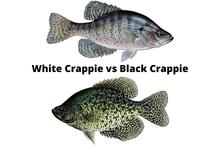
Most anglers think the main differences between white crappie vs black crappie are only superficial, but that’s not quite the case.
Crappie are widely considered to be the most popular species of panfish in North America, which is a notable distinction considering the fact that there are dozens of panfish species and variations present in the United States and Canada.
If you’re one of the many anglers who are not aware of the differences between white crappie vs black crappie, we’ve compiled this article to serve as a handy guide for distinguishing between the two.
Crappie Overview
For many anglers, it’s not quite as easy as it might seem to tell the difference between black and white crappie. In many cases, these two species very closely resemble one another, but they also have certain distinct characteristics and qualities that set them apart.
Crappie from both species groups are among the most sought-after fish in North America due to the fact that their thin, sweet-tasting fillets are excellent table fare.
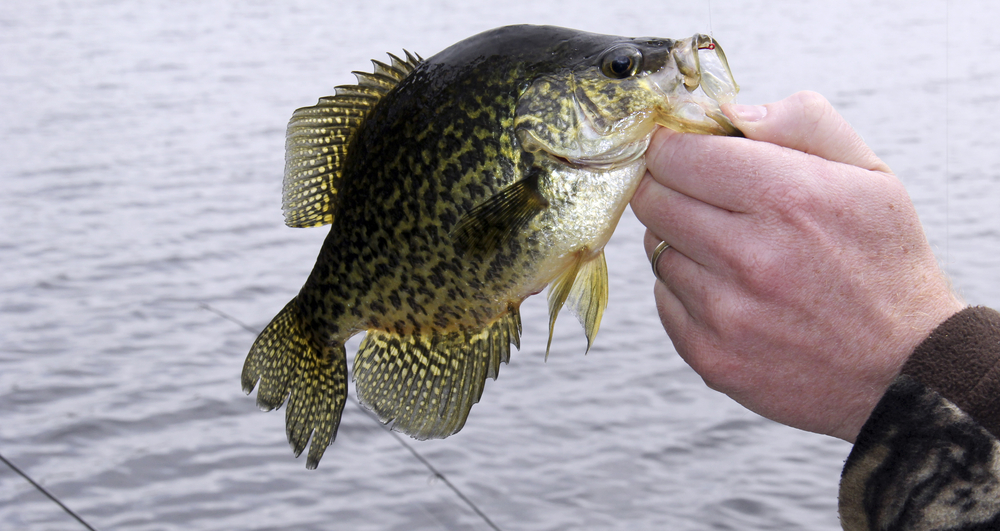
It’s understandable that even some experienced anglers can become confused with the differences between white vs black crappie as there are actually more variations known to exist throughout the continent.
The IGFA recognizes 7 different species of crappie and some of these are only found in certain geographic areas of the United States.
Crappie are part of the Sunfish family, but they are known as panfish among anglers due to the fact that their body shape is perfectly proportioned to fit inside the average frying pan.
White crappie and black crappie are known to be virtually the same size in many cases, but there are some slight and subtle differences in their growth rate and the way their bodies change as they grow older and larger.
All 7 different variations of crappie belong to the same Pomoxis genus within the Sunfish family. In order to fully understand these two species and have the ability to distinguish one from another, we’ll discuss more about white crappie vs black crappie in the following sections, including the finer details about each species.
White Crappie
Much like any other crappie species, white crappie are a very social fish species. They are known to congregate with large schools of their own kind for virtually the entire year.
If you manage to catch a white crappie in a large lake or reservoir, you might want to thoroughly fish the area as it’s nearly guaranteed that there will be more in that same area or very near to it.
As a prominent freshwater fish in North America, the white crappie can be found in many different lakes and rivers stretching throughout most of the United States and Canada. They are native to the Mississippi River system and the state of Mississippi is largely considered to be the crappie capital of the United States.
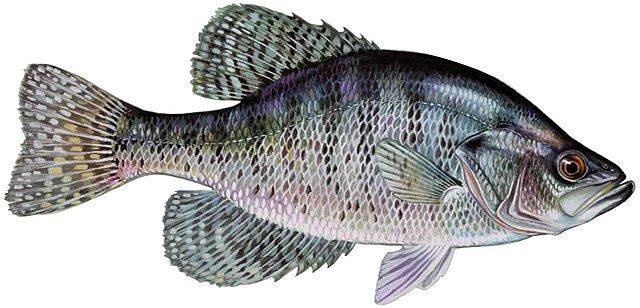
White crappie are quite different from black crappie in their chosen habitat. They often like to remain in deeper sections of the lakes and reservoirs where they are found, but white crappie are not quite as skittish and will congregate in open water instead of hugging tightly to certain types of cover.
The topic of whether white crappie are more inclined to live in rivers than black crappie has been debated for many years and there is ample evidence that shows white crappie generally prefer to live in large, slow-moving rivers or big reservoirs that these rivers feed into.
White crappie are very common throughout the Midwest and states along the Deep South, but it’s rare to find them in some of the northernmost states as the cold winters are not preferred by these fish.
Black Crappie
Black crappie are aptly-named as you can clearly notice their black coloration on most of these fish. However, some black crappie have a much lighter coloration than others, leading some anglers to mistakenly assume that they are white crappie.
Black crappie are known under the scientific name Pomoxis Nigromaculatus and are one of the more unique variations of fish within the 7 different crappie species known to exist in the United States.
While the white crappie likes to live in open water, you can expect to find black crappie very close to some type of submerged, deep-water cover in most cases.
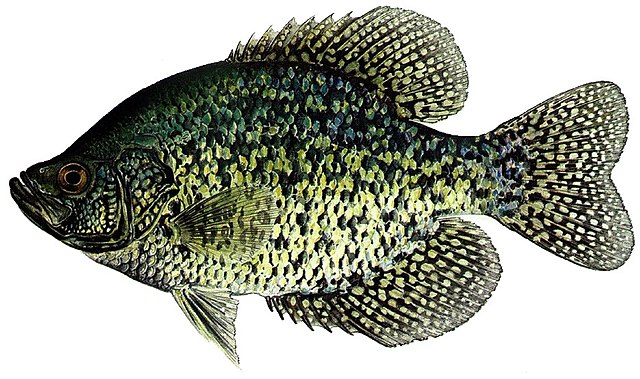
Many biologists believe that these fish have specifically evolved with their darker coloration as a means to hide near underwater logs, brush piles, rocks and other types of cover where they can more easily ambush their prey.
Black crappie have a slightly larger range than white crappie if you were to compare the two species’ natural habitats on a map of North America. They are found in virtually any river, lake or reservoir where white crappie are known to live, but some waterways have only black crappie in them.
Black crappie are native to the eastern and southern portions of the United States, but they have been introduced to lakes and reservoirs all across the country over the last 100 years.
Many of these lakes where they have been introduced are areas where black crappie tend to thrive, especially in states like California and Arizona that offer warmer climates.
Crappie Spawn
Black and white crappie have very similar spawning routines which they engage in at the onset of warmer weather in the spring of each year.
When the water temperature begins to warm up and reaches roughly 55 degrees Fahrenheit, you can expect both black and white crappie to begin their annual migration upward in the water column toward more shallow sections of their home body of water.
In large lakes and reservoirs, white and black crappie will start moving into coves where they can stage on points and locate certain sections where the males will create a nest in 2 to 6 feet of water in the back of a cove before the female comes in to lay her eggs.
Crappie often lay more than 10,000 eggs at a time, but most of the fry that come from these hatches will end up as food for other crappie and many other types of freshwater fish species.
White Crappie vs Black Crappie Differences
It’s true that it can be tough to distinguish white and black crappie from one another, but these identification points can be used to tell them apart with relative confidence for anglers who pay close attention to their catch.
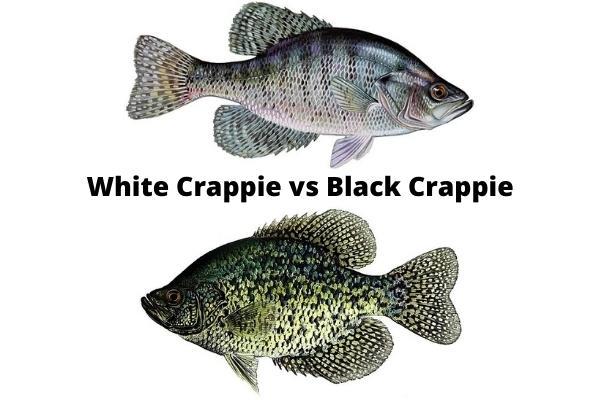
Markings & Color Pattern
For avid crappie anglers, the difference between white vs black crappie is often obvious with a single glance. Yet, others might not realize the subtle differences in the markings and color patterns that white and black crappie possess. These color and marking differences are hard to confuse and once you begin to notice it on your fishing trips, it will become relatively easy to tell white crappie from black crappie.
The white crappie will have a much lighter coloration on their sides, but sometimes black crappie might have a very light pattern themselves. It’s important to pay special attention to the black specs on crappie in order to tell whether the fish is a white or black crappie.
White crappie will have distinct specks that connect to form more obvious, dark-colored vertical stripes along their sides. Many times, these stripes can appear as if they wear with age, but some variations of white crappie have very clear and obvious black stripes along their sides.
Black crappie will have these same black specs all over their body in no significant pattern. They will always have more of these black specs along the upper portion of their body, especially along their backs, but these black specs often resemble a black-and-white digital camo pattern. In some cases, black crappie will have a much darker and obviously black coloration.
Dorsal Fin Spines
If you’re examining the fish and you’re still not quite sure whether it’s a black or white crappie, you can rely on another method to identify it. The dorsal fins of white crappie are known to have only 5 or 6 spikes while black crappie will have a few extra. You can always expect black crappie to have at least 7 ot 8 spikes on its dorsal fin and some anglers rely on counting these spikes to be fully certain of their catch.
Body Length
Lastly, the other difference between white and black crappie is one that’s more subtle and harder to identify for some anglers. White crappie often have a longer body than black crappie, despite the fact that their body profiles remain more rounded in both species. A trophy size black crappie might measure 13 inches while a trophy-sized white crappie can exceed 16 inches in some instances.
Conclusion
It’s fully understandable for some anglers to be confused about the differences between white vs black crappie, but you can gain a more solid understanding of each species using the information and identification factors provided in this article.
